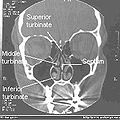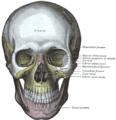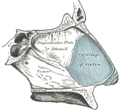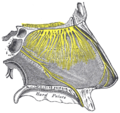Nasal cavity
| Nasal Cavity | |
|---|---|
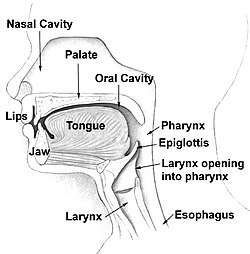 Head and neck. | |
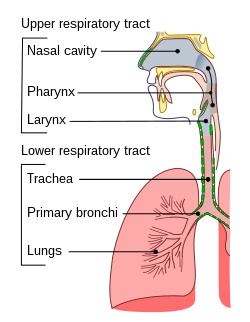 Conducting passages | |
| Details | |
| Identifiers | |
| Latin | cavum nasi; cavitas nasi |
| MeSH | D009296 |
| TA98 | A06.1.02.001 |
| TA2 | 3165 |
| FMA | 54378 |
| Anatomical terminology | |
The nasal cavity (or nasal fossa) is a large air filled space above and behind the nose in the middle of the face. Each cavity is the continuation of one of the two nostrils.
Function
The term "nasal cavity" can refer to each of the two sides of the nose or to the two sides combined. The two nasal cavities condition the air to be received by the other areas of the respiratory tract. Owing to the large surface area provided by the nasal conchae (also known as turbinates), the air passing through the nasal cavity is warmed or cooled to within 1 degree of body temperature. In addition, the air is humidified, and dust and other particulate matter is removed by vibrissae, short, thick hairs, present in the vestibule. The entire mucosa of the nasal fossae is covered by a blanket of mucus, which lies superficial to the microscopic cilia and also filters inspired air. The cilia of the respiratory epithelium move the secreted mucus and particulate matter posteriorly towards the pharynx where it passes into the esophagus and is digested in the stomach. The nasal cavity also houses our sense of smell and contributes greatly to taste sensation through its posterior communication with the mouth via the choanae.
Walls
The lateral wall of each nasal cavity is mainly made up by the maxilla, however there is a deficiency that is compensated by: the perpendicular plate of the palatine bone, the medial pterygoid plate, the labyrinth of ethmoid and the inferior concha. The paranasal sinuses are connected to the nasal cavity through small orifices called ostia. Most of these ostia communicate with the nose through the lateral nasal wall, via a semi-lunar depression in it known as the infundibulum. The infundibulum is bound laterally by a projection known as the uncinate process.
The roof of each nasal cavity is formed in its upper third to one half by the nasal bone and more inferiorly by the junctions of the upper lateral cartilage and nasal septum. Connective tissue and skin cover the bony and cartilaginous components of the dorsum of the nose.
The floor of the nasal cavities, which also form the roof of the mouth, is made up by the bones of the hard palate: the horizontal plate of the palatine bone posteriorly and the palatine process of the maxilla anteriorly. To the front of the nasal cavity is the nasal vestibule and external opening, while the back blends, via the choanae, into the nasopharynx.
The nasal cavity is divided in two by a vertical fin called the nasal septum. On the sides of the nasal cavity are three horizontal outgrowths called nasal conchae (singular "concha") or turbinates. These turbinates disrupt the airflow, directing air toward the olfactory epithelium on the surface of the turbinates and the septum. The vomeronasal organ is located at the back of the septum and has a role in pheromone detection.
Cilia and mucus
Cilia and mucus along the inside wall of the nasal cavity traps and removes dust and pathogens from the air as it flows through the nasal cavity. The cilia move the mucus down the nasal cavity to the pharynx, where it can be swallowed.
Segments
The nasal cavity is divided into two segments: the respiratory segment and the olfactory segment.
- The respiratory segment comprises most of each nasal fossa and is lined with ciliated pseudostratified columnar epithelium (also called respiratory epithelium). The conchae, or turbinates, are located in this region. The turbinates have a very vascularized lamina propria (erectile tissue) allowing the venous plexuses of their mucosa to engorge with blood, restricting airflow and causing air to be directed to the other side of the nose, which acts in concert by shunting blood out of its turbinates. This cycle occurs approximately every two and a half hours.
- The olfactory segment is lined with a specialized type of pseudostratified columnar epithelium, known as olfactory epithelium, which contains receptors for the sense of the smell. This segment is located in and beneath the mucosa of the roof of each nasal cavity and the medial side of each middle turbinate. Histological sections appear yellowish-brown due to the presence of lipofuscin pigments. Olfactory mucosal cell types include bipolar neurons, supporting (sustentacular) cells, basal cells, and Bowman's glands. The axons of the bipolar neurons form the olfactory nerve (cranial nerve I) which enters the brain through the cribiform plate. Bowman's glands are serous glands in the lamina propria, whose secretions trap and dissolve odoriferous substances.
Blood supply
There is a rich blood supply to the nasal cavity. In some animals, such as dogs, the capillary beds flowing through the nasal cavity help cool the blood flow to the brain.
Blood supply comes from branches of both the internal and external carotid artery, including branches of the facial artery and maxillary artery. The named arteries of the nose are:[1]
- Sphenopalatine and Greater palatine arteries, branches of the maxillary artery.
- Anterior ethmoidal artery and posterior ethmoidal artery, branches of the ophthalmic artery
- Septal Branches of the superior labial artery, a branch of the facial artery, which supplies the vestibule of the nasal cavity.
Innervation
Innervation of the nasal cavity responsible for the sense of smell is via the olfactory nerve, which sends microscopic fibers from the olfactory bulb through the cribriform plate to reach the top of the nasal cavity.
General sensory innervation is by branches of the trigeminal nerve (V1 & V2):
- Nasociliary nerve (V1)
- Nasopalatine nerve (V2)
- Posterior nasal branches of Maxillary nerve (V2)
There are two passages in the nasal cavity, not to be confused with nostrils.The entire nasal cavity is innervated by autonomic fibers. Sympathetic innervation to the blood vessels of the mucosa causes them to constrict, while the control of secretion by the mucous glands is carried on postganglionic parasympathetic nerve fibers originating from the facial nerve.
Diseases
This section needs expansion. You can help by adding to it. (February 2011) |
Diseases of the nasal cavity include viral, bacterial and fungal infections, nasal cavity tumors, both benign and much more often malignant, as well as inflammations of the nasal mucosa. Many problems can affect the nose, including:
- Deviated septum - a shifting of the wall that divides the nasal cavity into halves
- Nasal polyps - soft growths that develop on the lining of your nose or sinuses
- Nosebleeds
- Rhinitis - inflammation of the nose and sinuses sometimes caused by allergies. The main symptom is a runny nose.
- Nasal fractures, also known as a broken nose
- Common cold
Additional images
-
Nasal cavity
-
Nasal cavity
-
Nose and nasal cavities
-
Normal Nose CT Front cross section
-
Coronal section of nasal cavities.
-
Anatomy of the nasal cavity
-
The skull from the front.
-
Left orbicularis oculi, seen from behind.
-
Lateral wall of nasal cavity.
-
Lateral wall of nasal cavity. (Conchae removed to reveal openings in wall.)
-
Medial wall (septum) of nasal cavity.
-
Nerves of the wall of the nasal cavity
-
Nasal cavity
See also
References
- ^ Moore, Keith L; Dalley, Arthur F. (1999). Clinically Oriented Anatomy. Philadelphia: Lippincott Williams & Wilkins.




